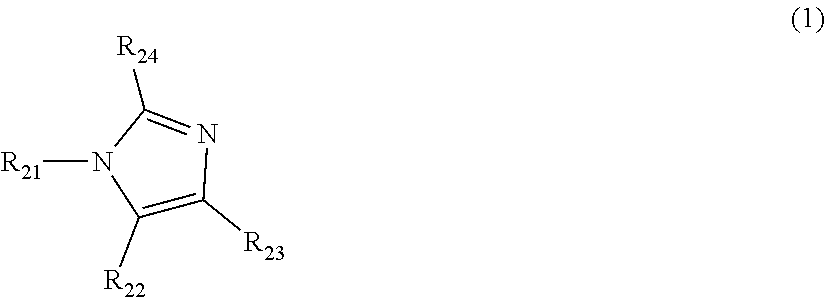Polyimidazoles for use as bile acid sequestrants
a technology of polyimidazoles and sequestrants, which is applied in the field of polyimidazoles for use as bile acid sequestrants, can solve the problems of large dose requirements, increased risk of coronary heart disease, and reduced patient compliance and toleran
- Summary
- Abstract
- Description
- Claims
- Application Information
AI Technical Summary
Benefits of technology
Problems solved by technology
Method used
Image
Examples
example 1
Aminopropyl imidazole (API) Polymers with dibromooctane, dibromodecane and dibromododecane
[0137]Synthesis of imidazole crosslinked materials were conducted using parallel synthesis. An imidazole monomer was dispensed into 40 mL glass vials. A solution of the crosslinking monomer of formula X—R1—X wherein Xis bromo and R1 is as listed in the table below (40 wt. % in N,N′-dimethyl formamide (DMF) in the case of 1,10-dibromodecane and 1,12-dibromododecane and neat in the case of dibromooctane), solvents and Na2CO3 were added to each vial. The vials were capped and heated for 17 hours at 70° C. Most vials contained a solid plug of polymer. The polymer was washed in water then swollen and ground in methanol, washed in methanol (twice), washed with aqueous hydrochloric acid (0.5 M), water(once), sodium hydroxide (0.01 M, three times), water (two times) and lyophilized until dry.
Monomer:CrosslinkingCrosslinkingCrosslinkerMonomermonomerAPIDMFMeOHNa2CO3Sample #(R1)Molar Ratio(mg)(uL)(uL)(uL)...
example 2
Aminopropyl imidazole (API) Polymers with dibromopropane—Comparator
[0139]Synthesis of imidazole crosslinked materials were conducted using parallel synthesis. An imidazole monomer was dispensed into a 40 mL glass vial. Dibromopropane and Na2CO3 were added to the vial. The vial was capped and heated for 17 hours at 70° C. The vial contained a solid plug of polymer. The polymer was washed in water then swollen and ground in methanol, washed in methanol (twice), washed with aqueous hydrochloric acid (0.5 M), water(once), sodium hydroxide (0.01 M, three times), water (two times) and lyophilized until dry.
Monomer:CrosslinkingDibromo-MonomerpropaneAPIDMFMeOHNa2CO3Sample #Molar Ratio(mg)(uL)(uL)(uL)(mg)1-A11:1.416751263172917292650
[0140]Bile acid binding capacity, affinity, and retention for each resulting polymer were determined via the A assay, B assay and hamster model and results are reported in the table below.
Bile acidBile acidBile acidbindingbindingbindingBAaffinitycapacityRententio...
example 3
Aminopropyl imidazole (API) Polymers with dichloroxylene
[0141]Synthesis of imidazole crosslinked materials were conducted using dispensing robots with liquid and powder dispensing capabilities. An imidazole monomer was dispensed into 8 mL glass vials. Dichloroxylene, solvents and Na2CO3 were added to each vial in amounts shown in the table below. The vials were capped and heated for 17 hours at 70° C. Most vials contained a solid plug of polymer. The polymer was washed in water then swollen and ground in methanol, washed in methanol (twice), washed with aqueous hydrochloric acid (0.5 M), water(once), sodium hydroxide (0.01 M, three times), water (two times) and lyophilized until dry.
Monomer:CrosslinkingDichloro-SampleMonomerxyleneAPIDMFMeOHNa2CO3#Molar Ratio(mg)(uL)(uL)(uL)(mg)2-B31:1.13081911882253392-B41:1.43921912192623392-B51:1.74761912502993392-B61:2 559191282336339
[0142]Bile acid binding capacity, affinity, and retention for each resulting polymer were determined via the A as...
PUM
| Property | Measurement | Unit |
|---|---|---|
| logP (cLog P) | aaaaa | aaaaa |
| glass transition temperature | aaaaa | aaaaa |
| glass transition temperature | aaaaa | aaaaa |
Abstract
Description
Claims
Application Information
 Login to View More
Login to View More - R&D
- Intellectual Property
- Life Sciences
- Materials
- Tech Scout
- Unparalleled Data Quality
- Higher Quality Content
- 60% Fewer Hallucinations
Browse by: Latest US Patents, China's latest patents, Technical Efficacy Thesaurus, Application Domain, Technology Topic, Popular Technical Reports.
© 2025 PatSnap. All rights reserved.Legal|Privacy policy|Modern Slavery Act Transparency Statement|Sitemap|About US| Contact US: help@patsnap.com



